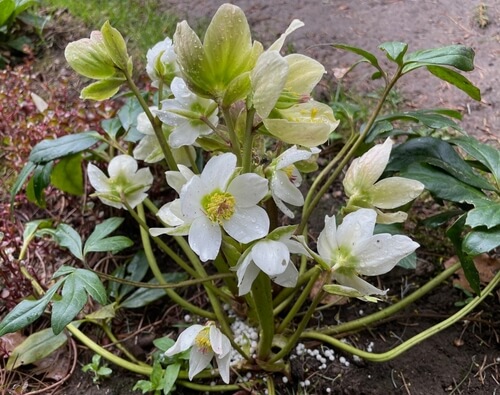Description
Helleborus, commonly known as hellebores, is a genus of flowering plants in the family Ranunculaceae. Commonly known as hellebores or Lenten roses, Helleborus species are prized for their early blooming nature, attractive foliage, and ability to thrive in shade. most of which are native to Europe and Asia.
Climate: Helleborus species have a wide climatic range. They are well-adapted to temperate climates, including regions with mild winters and cool summers. Some species can tolerate colder temperatures, while others prefer milder conditions. Choose species suitable for your specific climate and provide protection in extreme conditions.
Watering: Helleborus plants have moderate water needs. They prefer regular watering to keep the soil consistently moist but not waterlogged. Water deeply, ensuring that the root zone is thoroughly soaked. However, they can tolerate short periods of dryness once established. Avoid overwatering, as it can lead to root rot.
Soil Type: Helleborus plants prefer well-draining soil with a slightly acidic to neutral pH. They can tolerate a range of soil types, including loam, sandy soil, or clay soil. Ensure good drainage to prevent waterlogged conditions. Amending heavy clay soil with organic matter can improve its structure and drainage.
Fertilizing: Helleborus plants do not require heavy fertilization. Before planting, incorporate well-rotted compost or organic matter into the soil to provide nutrients. Once established, a light application of a balanced, slow-release fertilizer in early spring can promote healthy growth. Follow the package instructions for the recommended dosage and frequency.
Pest & Diseases: Helleborus plants are generally resistant to pests and diseases. However, they can occasionally be affected by aphids or slugs. Monitor the plants regularly for any signs of infestation and take appropriate measures to control the pests. Good air circulation and avoiding overhead watering can help prevent fungal diseases.
Pruning: Helleborus plants require minimal pruning. Remove any damaged or yellowing leaves in early spring to tidy up the plants. After flowering, trim back the old flower stems to the base to promote fresh growth. Avoid heavy pruning, as Helleborus plants have a long-lived and architectural nature.
Propagation: Helleborus plants can be propagated through division, seed sowing, or tissue culture. Division is typically done in early spring or early autumn when the plants are not actively growing. Seeds can be collected and sown indoors or outdoors in late spring. Tissue culture is a method primarily used by nurseries to propagate specific cultivars.
Landscape Uses: Helleborus plants are excellent for shaded or woodland gardens, borders, or containers. They provide early color and interest during late winter and early spring when few other plants are in bloom. Helleborus species also work well in mass plantings or as ground covers, adding beauty and texture to the landscape.
Cultivars: There are numerous cultivated varieties of Helleborus available, offering variations in flower color, size, and form. Some popular cultivars include Helleborus orientalis ‘Double Ellen Pink’ with double pink flowers, Helleborus niger ‘Christmas Rose’ with white flowers, and Helleborus x hybridus ‘Winter Jewels Amber Gem’ with unique amber-colored blooms. These cultivars provide options for different design preferences and can enhance the beauty and diversity of your garden.


